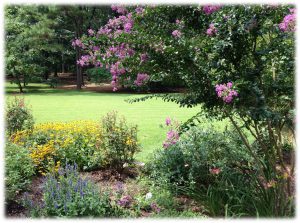Have you ever threatened to pave your lawn? Maybe the lawn grass is trying to tell you something.
Not every square foot of a landscape needs to be a well-manicured lawn. Maybe you picked the wrong lawn grass for the site. Maybe you are incorrectly managing the lawn grass that you have. Maybe trees are winning the battle with the lawn.

Lawn grass should be used where it serves a purpose, where it is needed and where it will grow.
People sometimes go to great efforts to grow grass where grass will not grow, and without ever considering an alternative.
Sometimes we try to grow a lawn in an area that is not well suited for lawn grass. Examples include areas where there is too much shade and/or tree competition and in areas that stay too wet, causing the lawn roots to decay. Sometimes a lawn declines and thins simply as a result of its age. In this case, the best solution may be to redo or to renovate an older, declining lawn.
I will address these issues and offer alternatives to lawn grass during this hour-long presentation titled Do You Really Need Lawn Grass.
This free presentation begins at 10 a.m. on Wednesday, March 15 and will be held at the Extension Office located at 3098 Airport Road in Crestview, Florida.
Seating is limited. You’ll need to register on Eventbrite. Here is the link to register.
https://LAWN_LECTURE.eventbrite.com
Call the Extension Office at (850) 689-5850 for more details.
Common contributors to the decline of a Florida lawn include the following.
- Soil compaction
- Nutrient imbalances (too much nitrogen and phosphorus and too little potassium)
- Tree competition (from both tree roots and tree shade)
- Lawn root pests (diseases and insects)
- Improper lawn maintenance practices (mowing too low, excessive fertilization and irrigating incorrectly)
In the process of starting over, decide where lawn grass is needed or where it serves a purpose and consider other options in areas where grass may not be needed or where grass does not grow well. Mulch or a shade tolerate groundcover may be a better choice where there are large trees. As grass declines in high traffic areas, consider pavement or mulch. In naturally wet areas, consider plants that do well on wet sites.
I’m not saying that we should do away with our lawns. I am saying that perhaps our expectations for our lawns are too high. And finally, take time to become better familiar with the type of lawn grass you have along with how to correctly manage it.
Source: UF/IFAS Pest Alert
Note: All images and contents are the property of UF/IFAS.



